Analyzing Gagne's Nine Events: A Case Study in Chemistry Education
VerifiedAdded on 2022/10/12
|5
|1624
|65
Homework Assignment
AI Summary
This assignment provides a comprehensive discussion of Gagne's nine events of instruction, a framework designed to optimize the learning process. The assignment details each of the nine events: gaining attention, informing learners of objectives, stimulating recall of prior learning, presenting the content, providing learning guidance, eliciting performance (practice), providing feedback, assessing performance, and enhancing retention and transfer. Furthermore, the assignment illustrates how these events can be effectively implemented within a chemistry classroom setting. Concrete examples are provided, demonstrating how to apply each event to enhance student engagement, knowledge acquisition, and skill development in chemistry. The author emphasizes the importance of each step to create a more effective and engaging learning experience. By using this framework, the assignment promotes efficient teaching strategies and also it enhances the student's ability to retain and share the knowledge and skills acquired from their courses.
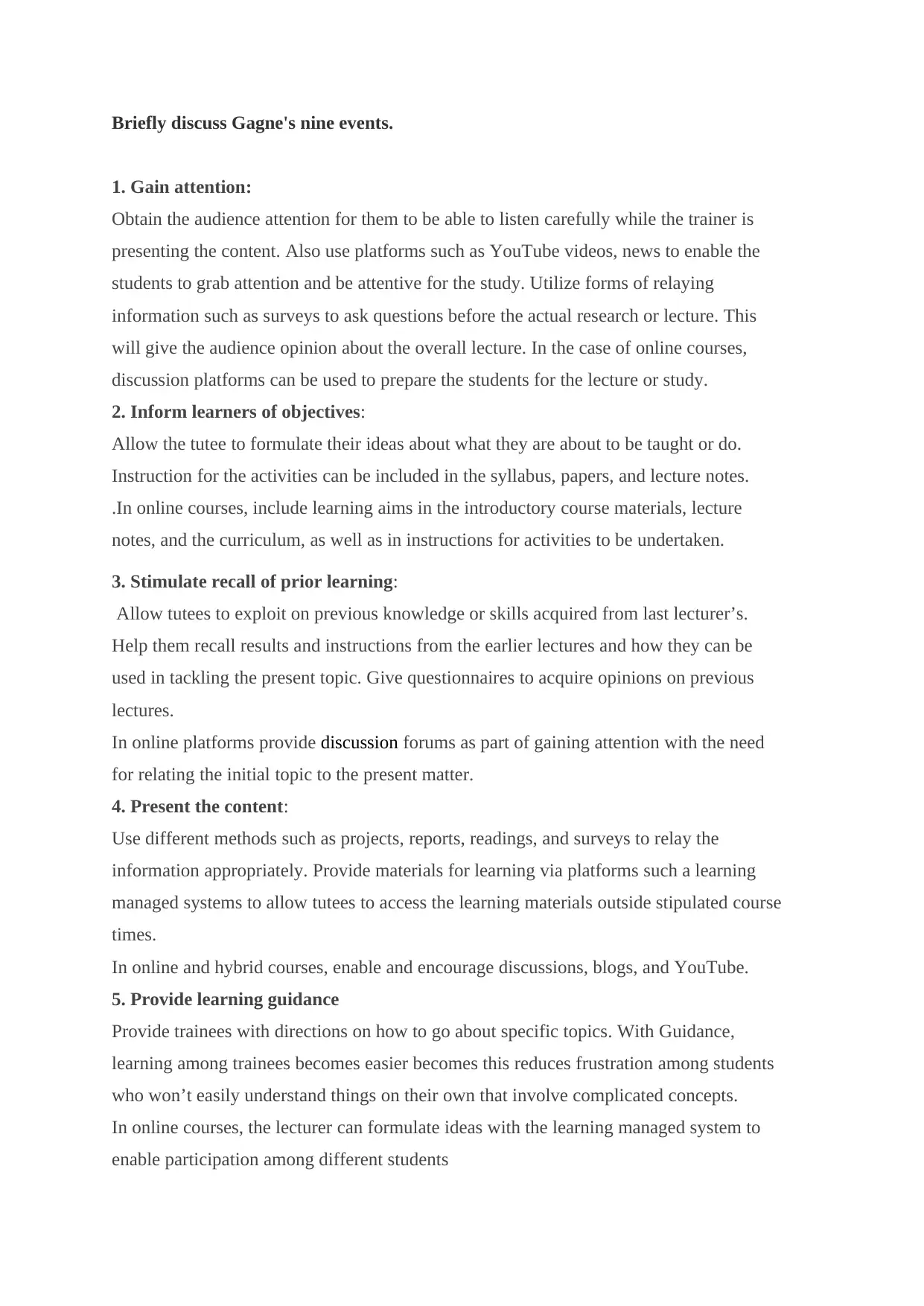
Briefly discuss Gagne's nine events.
1. Gain attention:
Obtain the audience attention for them to be able to listen carefully while the trainer is
presenting the content. Also use platforms such as YouTube videos, news to enable the
students to grab attention and be attentive for the study. Utilize forms of relaying
information such as surveys to ask questions before the actual research or lecture. This
will give the audience opinion about the overall lecture. In the case of online courses,
discussion platforms can be used to prepare the students for the lecture or study.
2. Inform learners of objectives:
Allow the tutee to formulate their ideas about what they are about to be taught or do.
Instruction for the activities can be included in the syllabus, papers, and lecture notes.
.In online courses, include learning aims in the introductory course materials, lecture
notes, and the curriculum, as well as in instructions for activities to be undertaken.
3. Stimulate recall of prior learning:
Allow tutees to exploit on previous knowledge or skills acquired from last lecturer’s.
Help them recall results and instructions from the earlier lectures and how they can be
used in tackling the present topic. Give questionnaires to acquire opinions on previous
lectures.
In online platforms provide discussion forums as part of gaining attention with the need
for relating the initial topic to the present matter.
4. Present the content:
Use different methods such as projects, reports, readings, and surveys to relay the
information appropriately. Provide materials for learning via platforms such a learning
managed systems to allow tutees to access the learning materials outside stipulated course
times.
In online and hybrid courses, enable and encourage discussions, blogs, and YouTube.
5. Provide learning guidance
Provide trainees with directions on how to go about specific topics. With Guidance,
learning among trainees becomes easier becomes this reduces frustration among students
who won’t easily understand things on their own that involve complicated concepts.
In online courses, the lecturer can formulate ideas with the learning managed system to
enable participation among different students
1. Gain attention:
Obtain the audience attention for them to be able to listen carefully while the trainer is
presenting the content. Also use platforms such as YouTube videos, news to enable the
students to grab attention and be attentive for the study. Utilize forms of relaying
information such as surveys to ask questions before the actual research or lecture. This
will give the audience opinion about the overall lecture. In the case of online courses,
discussion platforms can be used to prepare the students for the lecture or study.
2. Inform learners of objectives:
Allow the tutee to formulate their ideas about what they are about to be taught or do.
Instruction for the activities can be included in the syllabus, papers, and lecture notes.
.In online courses, include learning aims in the introductory course materials, lecture
notes, and the curriculum, as well as in instructions for activities to be undertaken.
3. Stimulate recall of prior learning:
Allow tutees to exploit on previous knowledge or skills acquired from last lecturer’s.
Help them recall results and instructions from the earlier lectures and how they can be
used in tackling the present topic. Give questionnaires to acquire opinions on previous
lectures.
In online platforms provide discussion forums as part of gaining attention with the need
for relating the initial topic to the present matter.
4. Present the content:
Use different methods such as projects, reports, readings, and surveys to relay the
information appropriately. Provide materials for learning via platforms such a learning
managed systems to allow tutees to access the learning materials outside stipulated course
times.
In online and hybrid courses, enable and encourage discussions, blogs, and YouTube.
5. Provide learning guidance
Provide trainees with directions on how to go about specific topics. With Guidance,
learning among trainees becomes easier becomes this reduces frustration among students
who won’t easily understand things on their own that involve complicated concepts.
In online courses, the lecturer can formulate ideas with the learning managed system to
enable participation among different students
Paraphrase This Document
Need a fresh take? Get an instant paraphrase of this document with our AI Paraphraser
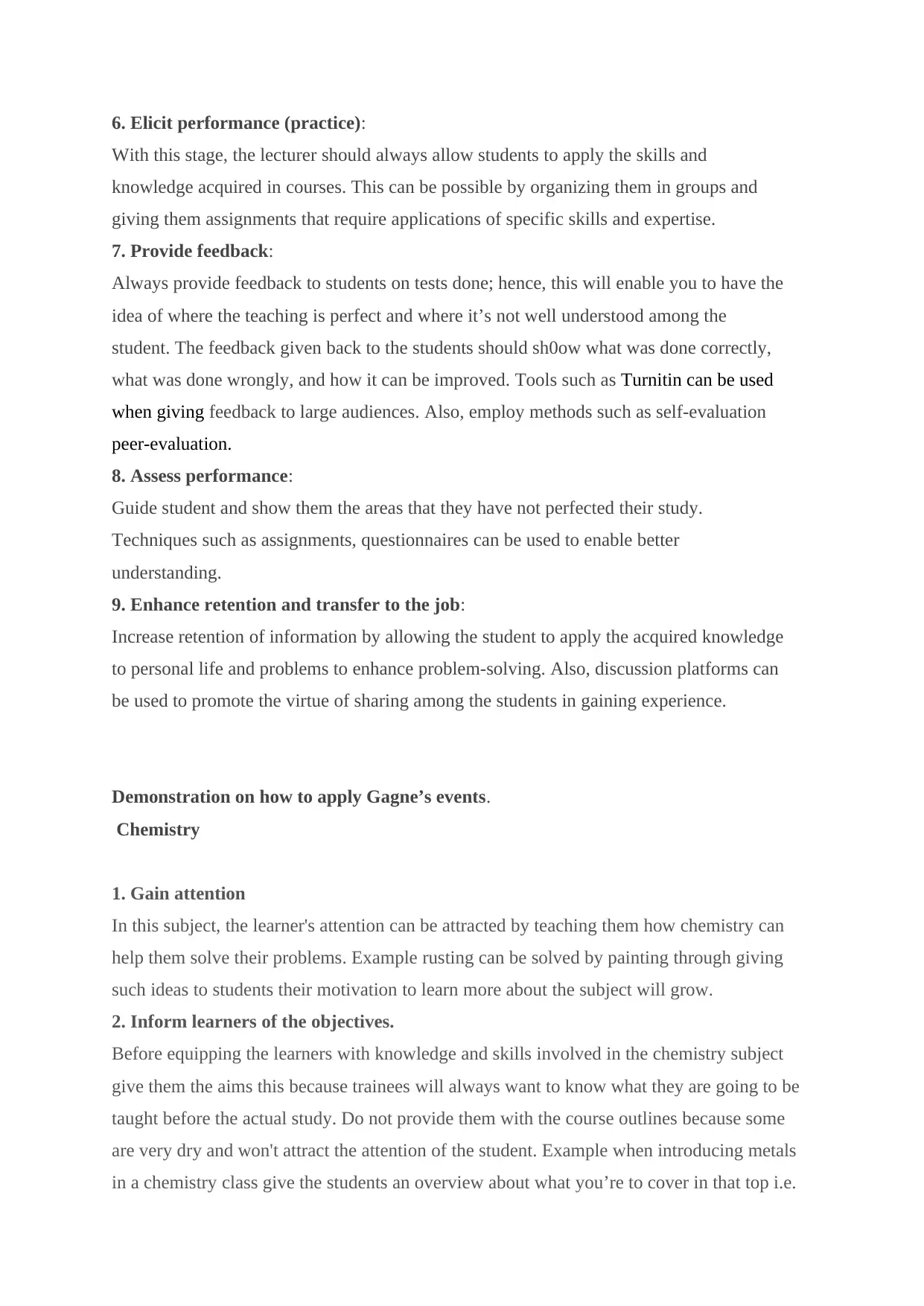
6. Elicit performance (practice):
With this stage, the lecturer should always allow students to apply the skills and
knowledge acquired in courses. This can be possible by organizing them in groups and
giving them assignments that require applications of specific skills and expertise.
7. Provide feedback:
Always provide feedback to students on tests done; hence, this will enable you to have the
idea of where the teaching is perfect and where it’s not well understood among the
student. The feedback given back to the students should sh0ow what was done correctly,
what was done wrongly, and how it can be improved. Tools such as Turnitin can be used
when giving feedback to large audiences. Also, employ methods such as self-evaluation
peer-evaluation.
8. Assess performance:
Guide student and show them the areas that they have not perfected their study.
Techniques such as assignments, questionnaires can be used to enable better
understanding.
9. Enhance retention and transfer to the job:
Increase retention of information by allowing the student to apply the acquired knowledge
to personal life and problems to enhance problem-solving. Also, discussion platforms can
be used to promote the virtue of sharing among the students in gaining experience.
Demonstration on how to apply Gagne’s events.
Chemistry
1. Gain attention
In this subject, the learner's attention can be attracted by teaching them how chemistry can
help them solve their problems. Example rusting can be solved by painting through giving
such ideas to students their motivation to learn more about the subject will grow.
2. Inform learners of the objectives.
Before equipping the learners with knowledge and skills involved in the chemistry subject
give them the aims this because trainees will always want to know what they are going to be
taught before the actual study. Do not provide them with the course outlines because some
are very dry and won't attract the attention of the student. Example when introducing metals
in a chemistry class give the students an overview about what you’re to cover in that top i.e.
With this stage, the lecturer should always allow students to apply the skills and
knowledge acquired in courses. This can be possible by organizing them in groups and
giving them assignments that require applications of specific skills and expertise.
7. Provide feedback:
Always provide feedback to students on tests done; hence, this will enable you to have the
idea of where the teaching is perfect and where it’s not well understood among the
student. The feedback given back to the students should sh0ow what was done correctly,
what was done wrongly, and how it can be improved. Tools such as Turnitin can be used
when giving feedback to large audiences. Also, employ methods such as self-evaluation
peer-evaluation.
8. Assess performance:
Guide student and show them the areas that they have not perfected their study.
Techniques such as assignments, questionnaires can be used to enable better
understanding.
9. Enhance retention and transfer to the job:
Increase retention of information by allowing the student to apply the acquired knowledge
to personal life and problems to enhance problem-solving. Also, discussion platforms can
be used to promote the virtue of sharing among the students in gaining experience.
Demonstration on how to apply Gagne’s events.
Chemistry
1. Gain attention
In this subject, the learner's attention can be attracted by teaching them how chemistry can
help them solve their problems. Example rusting can be solved by painting through giving
such ideas to students their motivation to learn more about the subject will grow.
2. Inform learners of the objectives.
Before equipping the learners with knowledge and skills involved in the chemistry subject
give them the aims this because trainees will always want to know what they are going to be
taught before the actual study. Do not provide them with the course outlines because some
are very dry and won't attract the attention of the student. Example when introducing metals
in a chemistry class give the students an overview about what you’re to cover in that top i.e.
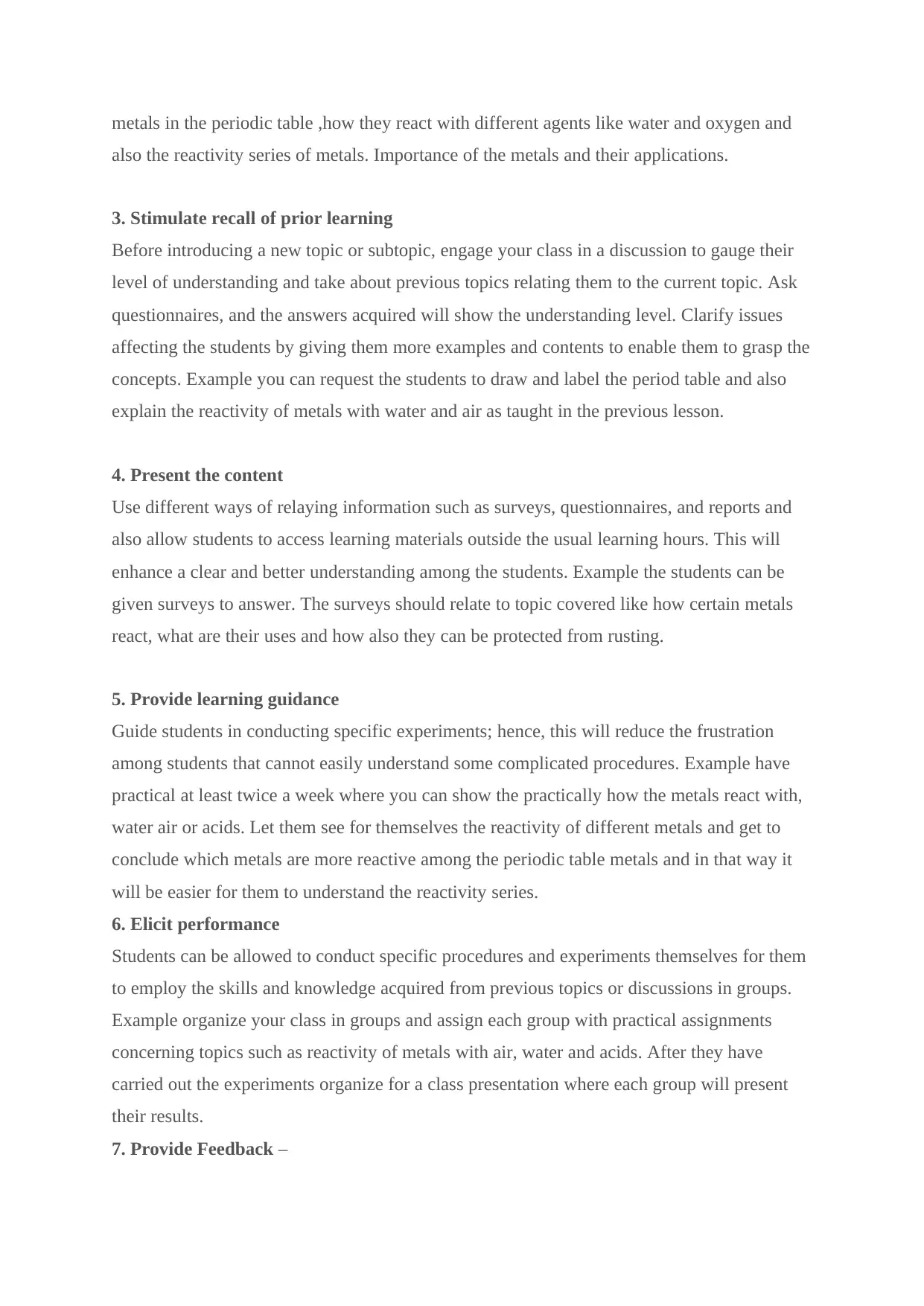
metals in the periodic table ,how they react with different agents like water and oxygen and
also the reactivity series of metals. Importance of the metals and their applications.
3. Stimulate recall of prior learning
Before introducing a new topic or subtopic, engage your class in a discussion to gauge their
level of understanding and take about previous topics relating them to the current topic. Ask
questionnaires, and the answers acquired will show the understanding level. Clarify issues
affecting the students by giving them more examples and contents to enable them to grasp the
concepts. Example you can request the students to draw and label the period table and also
explain the reactivity of metals with water and air as taught in the previous lesson.
4. Present the content
Use different ways of relaying information such as surveys, questionnaires, and reports and
also allow students to access learning materials outside the usual learning hours. This will
enhance a clear and better understanding among the students. Example the students can be
given surveys to answer. The surveys should relate to topic covered like how certain metals
react, what are their uses and how also they can be protected from rusting.
5. Provide learning guidance
Guide students in conducting specific experiments; hence, this will reduce the frustration
among students that cannot easily understand some complicated procedures. Example have
practical at least twice a week where you can show the practically how the metals react with,
water air or acids. Let them see for themselves the reactivity of different metals and get to
conclude which metals are more reactive among the periodic table metals and in that way it
will be easier for them to understand the reactivity series.
6. Elicit performance
Students can be allowed to conduct specific procedures and experiments themselves for them
to employ the skills and knowledge acquired from previous topics or discussions in groups.
Example organize your class in groups and assign each group with practical assignments
concerning topics such as reactivity of metals with air, water and acids. After they have
carried out the experiments organize for a class presentation where each group will present
their results.
7. Provide Feedback –
also the reactivity series of metals. Importance of the metals and their applications.
3. Stimulate recall of prior learning
Before introducing a new topic or subtopic, engage your class in a discussion to gauge their
level of understanding and take about previous topics relating them to the current topic. Ask
questionnaires, and the answers acquired will show the understanding level. Clarify issues
affecting the students by giving them more examples and contents to enable them to grasp the
concepts. Example you can request the students to draw and label the period table and also
explain the reactivity of metals with water and air as taught in the previous lesson.
4. Present the content
Use different ways of relaying information such as surveys, questionnaires, and reports and
also allow students to access learning materials outside the usual learning hours. This will
enhance a clear and better understanding among the students. Example the students can be
given surveys to answer. The surveys should relate to topic covered like how certain metals
react, what are their uses and how also they can be protected from rusting.
5. Provide learning guidance
Guide students in conducting specific experiments; hence, this will reduce the frustration
among students that cannot easily understand some complicated procedures. Example have
practical at least twice a week where you can show the practically how the metals react with,
water air or acids. Let them see for themselves the reactivity of different metals and get to
conclude which metals are more reactive among the periodic table metals and in that way it
will be easier for them to understand the reactivity series.
6. Elicit performance
Students can be allowed to conduct specific procedures and experiments themselves for them
to employ the skills and knowledge acquired from previous topics or discussions in groups.
Example organize your class in groups and assign each group with practical assignments
concerning topics such as reactivity of metals with air, water and acids. After they have
carried out the experiments organize for a class presentation where each group will present
their results.
7. Provide Feedback –
⊘ This is a preview!⊘
Do you want full access?
Subscribe today to unlock all pages.

Trusted by 1+ million students worldwide
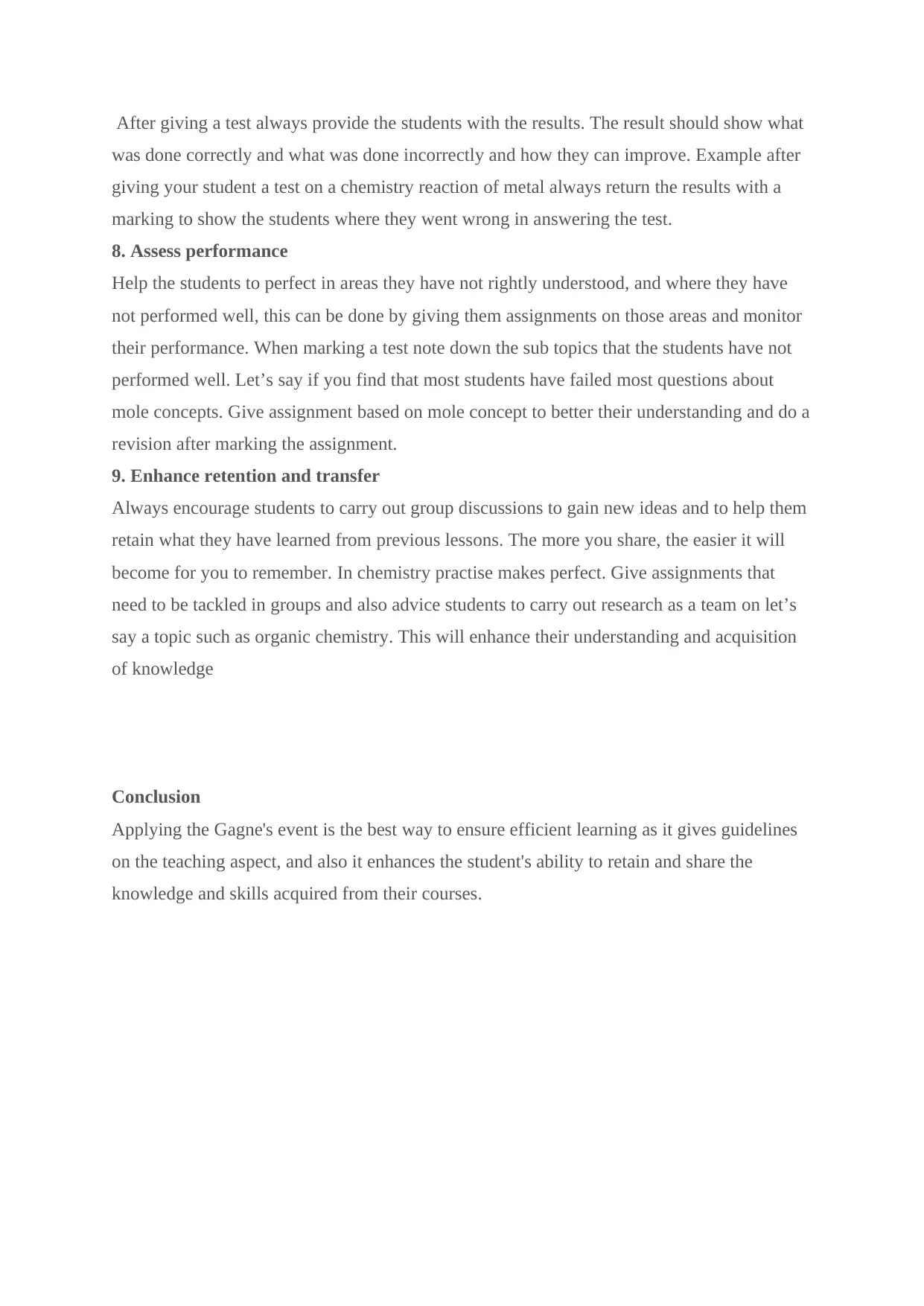
After giving a test always provide the students with the results. The result should show what
was done correctly and what was done incorrectly and how they can improve. Example after
giving your student a test on a chemistry reaction of metal always return the results with a
marking to show the students where they went wrong in answering the test.
8. Assess performance
Help the students to perfect in areas they have not rightly understood, and where they have
not performed well, this can be done by giving them assignments on those areas and monitor
their performance. When marking a test note down the sub topics that the students have not
performed well. Let’s say if you find that most students have failed most questions about
mole concepts. Give assignment based on mole concept to better their understanding and do a
revision after marking the assignment.
9. Enhance retention and transfer
Always encourage students to carry out group discussions to gain new ideas and to help them
retain what they have learned from previous lessons. The more you share, the easier it will
become for you to remember. In chemistry practise makes perfect. Give assignments that
need to be tackled in groups and also advice students to carry out research as a team on let’s
say a topic such as organic chemistry. This will enhance their understanding and acquisition
of knowledge
Conclusion
Applying the Gagne's event is the best way to ensure efficient learning as it gives guidelines
on the teaching aspect, and also it enhances the student's ability to retain and share the
knowledge and skills acquired from their courses.
was done correctly and what was done incorrectly and how they can improve. Example after
giving your student a test on a chemistry reaction of metal always return the results with a
marking to show the students where they went wrong in answering the test.
8. Assess performance
Help the students to perfect in areas they have not rightly understood, and where they have
not performed well, this can be done by giving them assignments on those areas and monitor
their performance. When marking a test note down the sub topics that the students have not
performed well. Let’s say if you find that most students have failed most questions about
mole concepts. Give assignment based on mole concept to better their understanding and do a
revision after marking the assignment.
9. Enhance retention and transfer
Always encourage students to carry out group discussions to gain new ideas and to help them
retain what they have learned from previous lessons. The more you share, the easier it will
become for you to remember. In chemistry practise makes perfect. Give assignments that
need to be tackled in groups and also advice students to carry out research as a team on let’s
say a topic such as organic chemistry. This will enhance their understanding and acquisition
of knowledge
Conclusion
Applying the Gagne's event is the best way to ensure efficient learning as it gives guidelines
on the teaching aspect, and also it enhances the student's ability to retain and share the
knowledge and skills acquired from their courses.
Paraphrase This Document
Need a fresh take? Get an instant paraphrase of this document with our AI Paraphraser
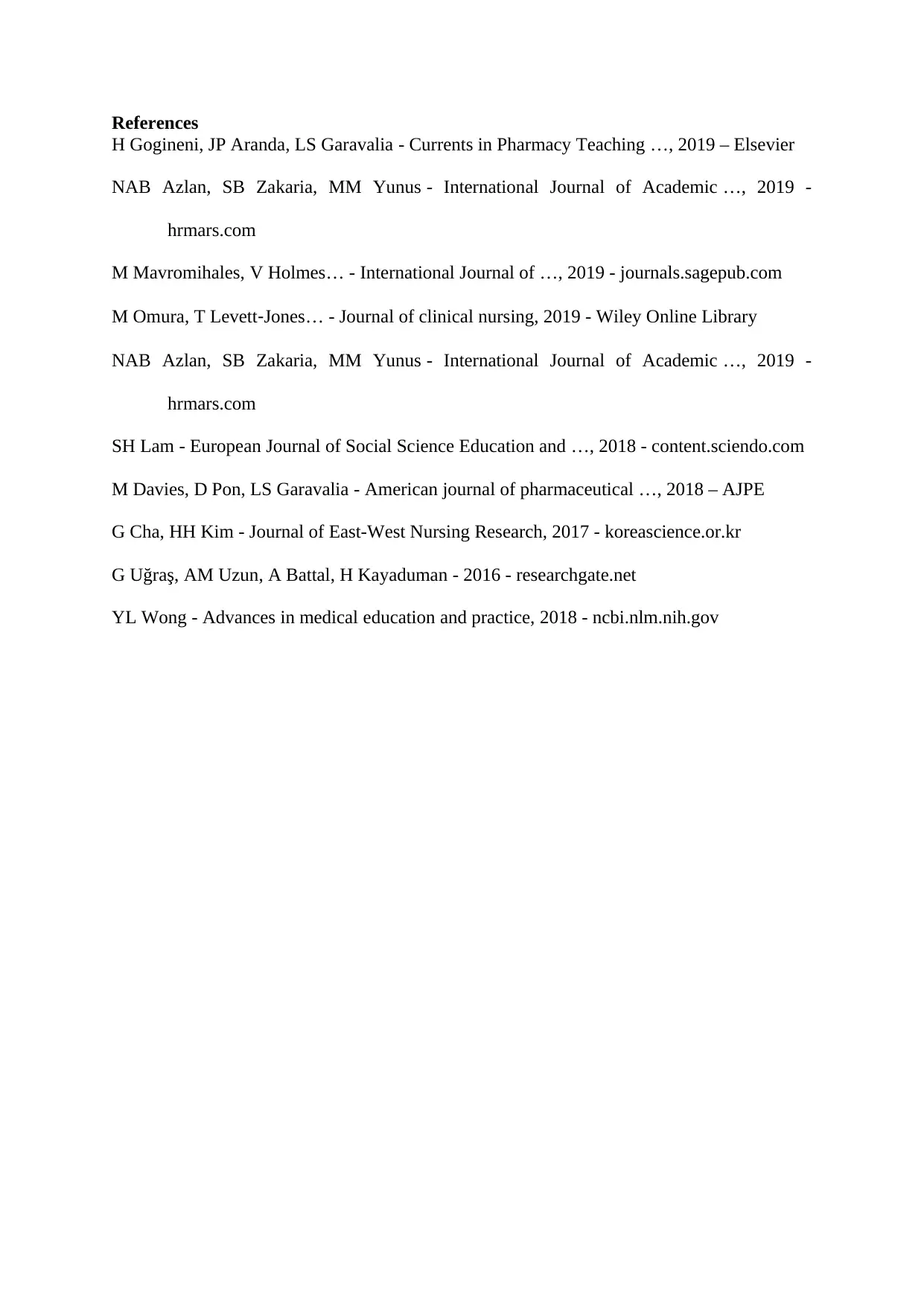
References
H Gogineni, JP Aranda, LS Garavalia - Currents in Pharmacy Teaching …, 2019 – Elsevier
NAB Azlan, SB Zakaria, MM Yunus - International Journal of Academic …, 2019 -
hrmars.com
M Mavromihales, V Holmes… - International Journal of …, 2019 - journals.sagepub.com
M Omura, T Levett‐Jones… - Journal of clinical nursing, 2019 - Wiley Online Library
NAB Azlan, SB Zakaria, MM Yunus - International Journal of Academic …, 2019 -
hrmars.com
SH Lam - European Journal of Social Science Education and …, 2018 - content.sciendo.com
M Davies, D Pon, LS Garavalia - American journal of pharmaceutical …, 2018 – AJPE
G Cha, HH Kim - Journal of East-West Nursing Research, 2017 - koreascience.or.kr
G Uğraş, AM Uzun, A Battal, H Kayaduman - 2016 - researchgate.net
YL Wong - Advances in medical education and practice, 2018 - ncbi.nlm.nih.gov
H Gogineni, JP Aranda, LS Garavalia - Currents in Pharmacy Teaching …, 2019 – Elsevier
NAB Azlan, SB Zakaria, MM Yunus - International Journal of Academic …, 2019 -
hrmars.com
M Mavromihales, V Holmes… - International Journal of …, 2019 - journals.sagepub.com
M Omura, T Levett‐Jones… - Journal of clinical nursing, 2019 - Wiley Online Library
NAB Azlan, SB Zakaria, MM Yunus - International Journal of Academic …, 2019 -
hrmars.com
SH Lam - European Journal of Social Science Education and …, 2018 - content.sciendo.com
M Davies, D Pon, LS Garavalia - American journal of pharmaceutical …, 2018 – AJPE
G Cha, HH Kim - Journal of East-West Nursing Research, 2017 - koreascience.or.kr
G Uğraş, AM Uzun, A Battal, H Kayaduman - 2016 - researchgate.net
YL Wong - Advances in medical education and practice, 2018 - ncbi.nlm.nih.gov
1 out of 5
Related Documents
Your All-in-One AI-Powered Toolkit for Academic Success.
+13062052269
info@desklib.com
Available 24*7 on WhatsApp / Email
![[object Object]](/_next/static/media/star-bottom.7253800d.svg)
Unlock your academic potential
Copyright © 2020–2025 A2Z Services. All Rights Reserved. Developed and managed by ZUCOL.





